
Louis Comfort Tiffany was an American artist and designer who worked in the decorative arts and is best known for his work in stained glass. He is associated with the art nouveau and aesthetic art movements.

Samuel Siegfried Bing, who usually gave his name as S. Bing, was a German-French art dealer who lived in Paris as an adult, and who helped introduce Japanese art and artworks to the West and was a factor in the development of the Art Nouveau style during the late nineteenth century.

John La Farge was an American artist whose career spanned illustration, murals, interior design, painting, and popular books on his Asian travels and other art-related topics. La Farge made stained glass windows, mainly for churches on the American east coast, beginning with a large commission for Henry Hobson Richardson's Trinity Church in Boston in 1878, and continuing for thirty years. La Farge designed stained glass as an artist, as a specialist in color, and as a technical innovator, holding a patent granted in 1880 for superimposing panes of glass. That patent would be key in his dispute with contemporary and rival Louis Comfort Tiffany.

Favrile glass is a type of iridescent art glass developed by Louis Comfort Tiffany. He patented this process in 1894 and first produced the glass for manufacture in 1896 in Queens, New York. It differs from most iridescent glasses because the color is ingrained in the glass itself, as well as having distinctive coloring. Tiffany won a grand prize at the 1900 Paris Exposition for his Favrile glass.

Samuel Colman was an American painter, interior designer, and writer, probably best remembered for his paintings of the Hudson River.
The Louis Comfort Tiffany Foundation was founded in 1918 by Louis Comfort Tiffany to operate his estate, Laurelton Hall, in Cold Spring Harbor, Long Island. It was designed to be a summer retreat for artists and craftspeople. In 1946 the estate closed and the foundation changed its purpose from a retreat to the bestowing of grants to artists.

Laurelton Hall was the home of noted artist Louis Comfort Tiffany, located in Laurel Hollow a village in the town of Oyster Bay in Long Island, New York. The 84-room mansion on 600 acres of land, designed in the Art Nouveau style, combined Islamic motifs with connection to nature, was completed in 1905, and housed many of Tiffany's most notable works, as well as serving as a work of art in and of itself. It was also commonly referred to as the "Oyster Bay estate".

Clara Driscoll of Tallmadge, Ohio, was head of the Tiffany Studios Women's Glass Cutting Department, in New York City. Using patterns created from the original designs, these women selected and cut the glass to be used in the famous lamps. Driscoll designed more than thirty Tiffany lamps produced by Tiffany Studios, among them the Wisteria, Dragonfly, Peony, and from all accounts her first — the Daffodil.
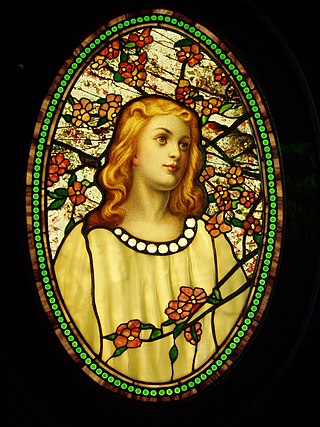
Tiffany glass refers to the many and varied types of glass developed and produced from 1878 to 1929-1930 at the Tiffany Studios in New York City, by Louis Comfort Tiffany and a team of other designers, including Clara Driscoll, Agnes F. Northrop, and Frederick Wilson.
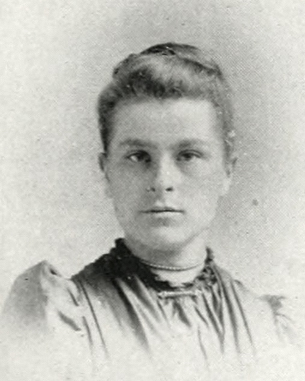
Alice Cordelia Morse was an American designer of book covers in the late 19th and early 20th centuries. Her work was inspired by the Arts and Crafts Movement, and she is often placed as one of the top three book designers of her day.
Florence Nightingale Levy was an American arts administrator notable for founding of the publication American Art Annual in 1898.
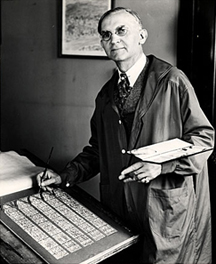
Charles Jay Connick (1875–1945) was a prominent American painter, muralist, and designer best known for his work in stained glass in the Gothic Revival style. Born in Springboro, Pennsylvania, Connick eventually settled in the Boston area where he opened his studio in 1913. Connick's work is contained in many preeminent churches and chapels, including examples in Boston, Chicago, Detroit, New York City, Pittsburgh, San Francisco, Seattle, and Washington, D.C. He also authored the book Adventures in Light and Color in 1937. Connick's studio continued to operate, and remained a leading producer of stained glass, until 1986.

The Tiffany Chapel is a chapel interior designed by Louis Comfort Tiffany and created by the Tiffany Glass and Decorating Company. First installed for the 1893 World's Columbian Exposition in Chicago, the chapel was later moved to the Cathedral of St. John the Divine in New York City, then re-acquired by Tiffany in 1916 and displayed in his own home. After the chapel was dismantled in 1949, parts were sold and the remaining portions were put on display at the Charles Hosmer Morse Museum of American Art in Winter Park, Florida in April 1999.
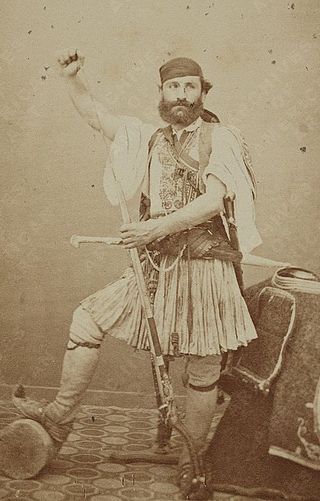
Lockwood de Forest was an American painter, interior designer and furniture designer. A key figure in the Aesthetic Movement, he introduced the East Indian craft revival to Gilded Age America.
Jeannette Genius McKean (1909–1989) was a painter, interior decorator, Louis Comfort Tiffany art glass collector, Morse Museum founder and benefactor of Rollins College. She is listed as a Great Floridian. The Jeanette Genius McKean Memorial 5k run is held annually in her honor.
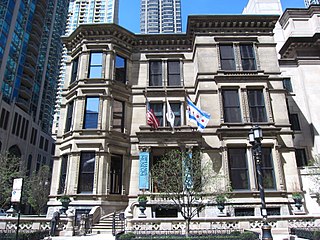
The Richard H. Driehaus Museum is a museum located at 40 East Erie Street on the Near North Side in Chicago, Illinois, near the Magnificent Mile. The museum is housed within the historic Samuel M. Nickerson House, the 1883 residence of a wealthy Chicago banker. Although the mansion has been restored, the Driehaus Museum does not re-create the Nickerson period but rather broadly interprets and displays the prevailing design, architecture, and decorating tastes of Gilded Age America and the art nouveau era in permanent and special exhibitions.

Helen Maitland Armstrong was an American stained glass artist who worked both solo and in partnership with her father, Maitland Armstrong. Her work is considered among the finest produced in America in the late 19th and early 20th centuries.

Frederick Wilson was a British stained glass artist best known for his work with Tiffany Studios. He was a prominent designer of ecclesiastical windows in the United States during the late 19th and early 20th centuries.

Alice Carmen Gouvy was a designer at Tiffany Studios and worked closely with Clara Driscoll, the head of the Women's Glass Cutting Department.

The 9:45 Accommodation is a 19th-century painting by American artist Edward Lamson Henry. Done in oil on canvas, the work depicts a train being boarded. Several notable versions of the painting have been produced, the first being an 1864 painting on wood panel and the second being an 1867 oil on canvas painting. The original 1864 work is in the collection of the Morse Museum of American Art, while the 1867 work is in the collection of the Metropolitan Museum of Art.




















